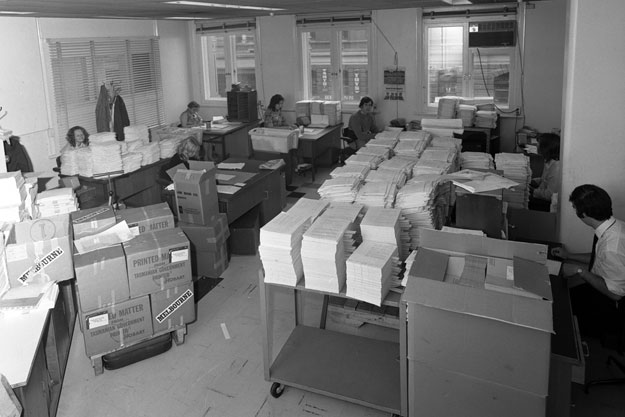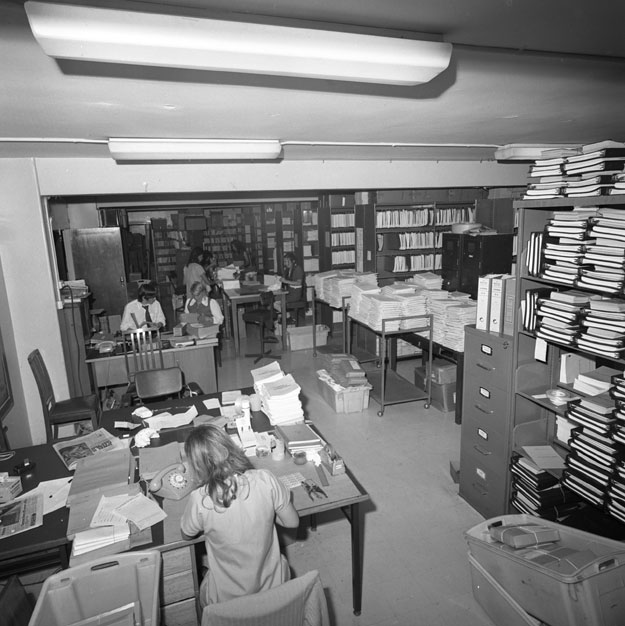The
Department's Publications Section
by
Roger Meyer
First recruit
in the printing team was photographer Ken Lobb, who helped to acquire
equipment with which to begin operations. This comprised a well-worn
Multilith printing machine, a process camera, and two photographic enlargers,
all being obtained from Army Disposals at nominal cost.
Additional staff comprising a printer, Alan Ebzery, an assistant photographer, Harry Reid and female typing and collating staff were also recruited. Production commenced in three rooms in Olderfleet Building (in Collins Street, Melbourne), one room being divided into two to form a dark room and a camera room, the second room being for the machinery and the third the collating room.
After a few years of ‘sardine’ conditions, they relocated to 12 McKillop Street, where the basement and half a floor were available. In spite of competition from rats and the hazards of narrow stairs, fire risk and other perils, the Section widened its field of customers. The prompt service the Section gave during the 1953 ICAO conference in Melbourne completely justified its existence.
When the Victoria-Tasmania Region moved from Almora House to 123 Latrobe Street, the ever-expanding Photographic and Printing Section also moved to these more commodious lodgings. By now, Frank Burgess was covering the outdoor and studio photography, and Roy Fuller was responsible for the large photolitho camera, and preparing plates for the printing machines.
Among their ongoing publications were quarterly statistics, Airways and Airports Engineering Instructions and the Vocabulary of Stores.
By 1963 the activities and responsibilities of the Department to the growing aviation industry for the provision of regulatory and advisory printed material led to the formation of the Publications Production Centre (PPC). The Centre was relocated to Rocke Tompsitt Building (near the corner of Flinders Street and Elizabeth Street), and occupied four floors of the building. Keith Lang was the Supervisor, and the unit of some 24 staff were part of the responsibility of Peter Riley, the Executive Officer (General Services). The Assistant Supervisor was Paul Rouse, and other ‘old hands’ included Ken Lobb, Frank Burgess, Ted Golian, Peter Barclay, Mike Lancaster and Stan Gibbs.
The boredom associated with the constant task of collating the many pages that comprised some documents led to dissatisfaction and to resignations. The solution was to employ part-time staff who would work for a few hours whenever required. These ladies thus employed enjoyed coming together, and many lasting friendships developed.
Following a stint in Aviation House, the PPC yet again relocated, this time to two successive locations in Swanston Street Carlton (just north of the city centre). The final Swanston St location had a small shop front where a wide range of aviation products could be purchased, in addition to the traditional 'Departmental' products. The early 1990s also saw the franchising of CAA products, such as charts, to re-sellers at airports around the country. Most product distribution was, however, still carried out by mail order.
The turn of the 21st Century saw the Printing and Publications Centre, as it was by then known, end its long association with Melbourne and move to its eighth - and perhaps final - location in Canberra.
Acknowledgment: Peter Riley contributed considerably to the more recent history of the Publications Section.

The photos above and below give some idea of the massive task involved in compiling, printing and distributing innumerable operational documents to the aviation industry. These images show the Publications Centre when it was in Melbourne, in about 1980.

Click on these links to see examples of Departmental publications:
-
DCA Annual Reports
-
An index of the 'DCA Publications' series
- Airways Navigation Facilities (ANFAC)
- Aerodrome Chart
- An index of the Transport Australia newsletter
(Photos: CAHS collection)
Back to the main Air
Safety index
If this page appears without menu bars at top and left, click here